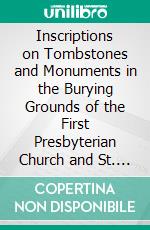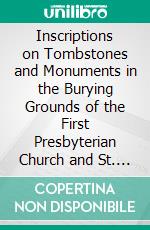Inscriptions on Tombstones and Monuments in the Burying Grounds of the First Presbyterian Church and St. Johns Church at Elizabeth, New Jersey: 1664-1892. E-book. Formato PDF - 9780259673798
di William Ogden Wheeler
edito da FORGOTTEN BOOKS , 2017
Formato: PDF - Protezione: nessuna
The settlement of Elizabethtown was the first within the bounds of New Jersey made by New England people. The Purchase of the land from the Indians was made by John Baily, Daniel Denton and Luke Watson of Jamaica, L. I., October 28, 1664, and the Patent granted by Gov. Nicolls to Capt. John Baker, John Ogden, John Baily, Luke Watson "and their associates," confirming the Indian deed, bears date December 1, 1664. John Ogden of Northampton had bought out Denton's interest, and Capt. John Baker of New York was probably allowed an interest in consideration of his services as interpreter. Gov. Nicolls when he signed this patent was no doubt ignorant of the deed from the Duke of York to Berkley and Carteret made on the 24th day of June previous. Dr. Hatfield in his history of Elizabeth, thinks it probable that a formal occupation was made upon the land between October and December 1664, and that occupation by actual settlers soon followed. Mr. William A. Whitehead, in his last edition of East Jersey under the Proprietors, gives proof that when Gov. Philip Carteret arrived in 1665, but four English-speaking families were to be found in New Jersey, pioneers of the Jamaica Colony. The patent granted by Governor Nicolls and the Indian purchase were relied upon in after years by the citizens as giving them a good title independent of that of Berkley and Carteret, but the latter grant was prior to the Nicolls patent and a vast amount of litigation was caused by these conflicting grants, lasting until the Revolutionary war put an end to it.<br><br>The first meeting house was of wood and of a very humble style of architecture. It was replaced by a new church in 1724, fifty-eight feet in length and forty-two feet in width. An addition in the rear of sixteen feet was made in 1766. On the night of January 25, 1780, a party of British troops and refugees, numbering nearly four hundred, crossed on the ice from Staten Island to Trembly's Point and were led by three Elizabethtown tories by the nearest and most retired route to the town. Here they secured a few prisoners, plundered many of the inhabitants, burned the Court House and Meeting House, and retreated with haste by way of De Hart's Point without loss. Washington spoke of this event a day or two after as "the late misfortune and disgrace of Elizabeth Town." The erection of a new church was commenced in 1784, and completed in 1789. It forms a part of the present edifice, and was extended and improved many times before it reached its present dimensions.<br><br>Dr. Kempshall in his historical discourse, delivered January 25, 1880, in celebrating the Centennial Anniversary of the burning of the church says:<br><br>"The lot on which the house was built included the present burying-ground, and extended on the west to the river (so called), and contained about eight acres.
Ean
9780259673798
Titolo
Inscriptions on Tombstones and Monuments in the Burying Grounds of the First Presbyterian Church and St. Johns Church at Elizabeth, New Jersey: 1664-1892. E-book. Formato PDF
Autore
Editore
Data Pubblicazione
2017
Formato
PDF
Protezione
nessuna
Punti Accumulabili



